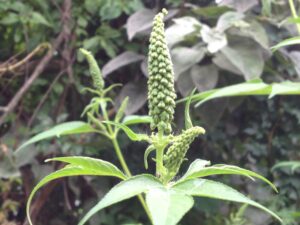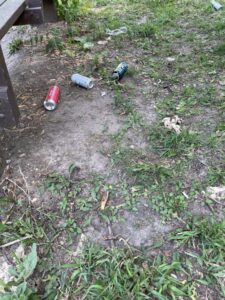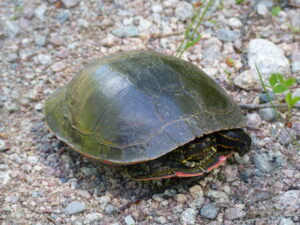Wisdom From “Johnny Appleseed” of Prairie Plants
“Weeds are mother nature’s stitches,” prairie restorationist Corliss “Jock” Ingels told us years ago.
“If you badly cut yourself, a physician stitches the wound closed so it can heal. If you bare the ground, weeds quickly sprout, shading the soil with foliage and filling it with roots. Weeds reduce erosion until more permanent plants take hold,” he proclaimed.

Even rag weed has a purpose. Birds love the seeds.
On a hot summer morning, we pedaled along the Grant Wood Trail, seeing mother nature’s stitches alongside the new pavement. Recently the popular bicycle trail was paved. Machines bared the soil at the edge of the pavement that’s now covered with bright yellow trefoil, crown and purple vetch, golden dandelions, white spurge, sweet clover, ragweed, and poison hemlock. All are so-called invasive weeds, but they’re providing a service by holding the soil and giving homes to trailside wildlife until more “desirable” plants establish. Some of those pioneering weeds sported an array of bright flowers that made our morning ride delightful.
Beyond Human Centric
Weeds have a purpose, but must a plant or animal need to have a “human-centric” perspective?
The night before our bike ride we sat on our back deck with Neil and Renata Bernstein. He’s a recently retired biology professor and remarked that sometimes people ask what purpose a particular plant or animal has.
Purpose! Must plants and animals have a purpose from a human perspective?

Easily recycled cans become trash.
Dr. Bernstein sometimes responds to these questions by saying, “What’s the purpose of people?” Indeed, our observations are that modern humans have forced out original people from their lands. We have done a great deal of harm by polluting the air, siphoning off life-giving water to maintain green grass, and stripping the land of topsoil, precious metals, and crystals. We greedily take a resource, convert it to our own purpose, then throw it away. “What’s the purpose of people?”
More to Purpose Than Our Perspective

We can learn much from turtles.
Some living things certainly have a great purpose. Without wheat, cattle, corn, penicillin mold, lumber, trees, and thousands of other plants and animals we couldn’t live. Others may seem to have a negative purpose. Think disease-causing microbes, poison ivy, ragweed that spews allergic pollen into the air, mosquitoes, and a host of other creatures that cause human misery. To view them negatively is human-centric.
The vast majority of living things neither produce tangible benefits nor problems for people. Like turtles, they simply live. Probably they have a valuable ecological role that may not be obvious but they are here. They have a right to be here whether or not they provide human impact. As we have learned over millennia, different plants and animals, offer benefits to us. We simply have to observe and incorporate.
To Everything…There is a Purpose
Every living thing has a purpose in the great scheme of things that people barely understand.
So, as we cycle along, we doff our bike helmets to the diversity of life we pass and silently thank them for sharing the world with us.


Thanks for the ruminations in the latest blog the purpose of everything including turtles. Whenever we travel the roads in the height of summer and see a turtle trying to make
its way across the road, we always stop. Of course, I’m the one who gets out and picks it up and and keeps it headed in the direction we saw it going. Once the turtle we stopped to help was much larger and fussed at me. So rather than picking it up, I just helped it in its chosen direction. Methinks it might have been a snapping turtle as the others were the smaller painted turtle.
Thanks, Jackie. Look up on line about snappers. They have serrated back edges. Good to stay away from as you did.